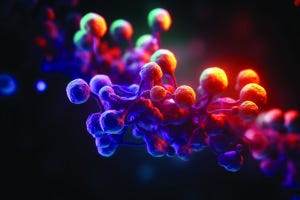Demystifying Mixed-Mode Chromatography Resins: Emerging Applications for Purification of Non-MAb Protein TherapeuticsDemystifying Mixed-Mode Chromatography Resins: Emerging Applications for Purification of Non-MAb Protein Therapeutics

Although monoclonal antibodies (MAbs) still represent the most common and most lucrative drug class in the biopharmaceutical industry, enthusiasm is growing for other recombinant-protein products. Clinical pipelines and even commercial portfolios are beginning to feature a breadth of nonantibody proteins and fragments as well as variations on the conventional-antibody theme: e.g., single-chain variable fragments (scFvs), fragment antigen-binding (Fab) products, and single-domain antibody fragments (also called nanobodies). By exploring such formats, drug developers hope to continue leveraging the efficacy advantages of protein binding while surmounting key technical and economic obstacles associated with MAb manufacturing. A chief concern, Simeon and Chen point out, is that MAbs usually require mammalian (often murine) expression systems that can perform the correct posttranslational modifications, including glycosylation. Such hosts entail complex production processes that require expensive consumables, exacting high costs that are passed in turn to patients. By contrast, non-MAb proteins might not require glycosylation, enabling use of microbial and other expression systems that require less-expensive materials and simpler production processes. Compared with MAbs, alternative protein biologics also could exhibit higher thermostability and greater resistance to chemical degradation (1).
However, questions remain for downstream purification of non-MAb proteins. As I learned from Nick Vecchiarello, an assistant professor of chemical engineering at the University of Virginia, industry-standard protein A chromatography resins are unsuitable for proteins and antibody fragments that lack crystallizable fragment (Fc) regions. Thus, emerging protein biologics will require novel separation techniques. The Vecchiarello Laboratory designs peptide-functionalized matrices to improve scientific understanding of chromatography media interactions with therapeutic proteins. At the February 2023 BPI West Conference and Exhibition and the May 2023 BPI Europe event, Vecchiarello explored opportunities for improving non-MAb purification using mixed-mode chromatography media (2). He also described his team’s efforts to perform high-throughput screening of candidate resins. In doing so, the group hopes to develop comprehensive ligand libraries that can be used to facilitate selection of optimal sets of mixed-mode resins. I spoke with Vecchiarello before his BPI Europe presentation to learn more about the distinctive purification requirements of non-MAb therapeutics and the potential advantages of mixed-mode media.
Vecchiarello earned a PhD in chemical and biological engineering at Rensselaer Polytechnic Institute (Troy, NY) while studying with Dr. Steven Cramer. Before joining the faculty at the University of Virginia in January 2023, he worked as a late-stage purification scientist at Amgen in Cambridge, MA, and as a postdoctoral researcher in the chemistry department at the Massachusetts Institute of Technology (MIT, Cambridge, MA).
The Need for Novel Separations
Why are non-MAb protein therapeutics more difficult to purify than their MAb counterparts? We can think about the complexities from a few angles. The first consideration is that a standard protein A affinity-chromatography resin will not purify therapeutic proteins that lack an Fc region. So off-the-shelf protein A options are unsuitable for non-MAb products.
Because of that limitation, you also need to think critically about your product’s impurity profile, including its host-cell protein (HCP) content. The protein A step does a good job of bringing HCP levels down, for example, to a couple of hundred parts per million (ppm). But a traditional ion-exchange (IEX) or hydrophobic-interaction (HIC) chromatography step usually will not achieve such specificity, so those impurities can be carried over into the next step.
In such cases, you must consider not only how a given step operates, but also how steps might be paired. That factor brings additional work, but it also brings opportunities. For example, you could identify two steps that remove nonoverlapping sets of impurities such that those steps purify your product more effectively than a single protein A step could. In separation sciences, we call that principle orthogonality.
A separate consideration is that MAbs tend to have high isoelectric points (pI values), and HCPs generated during culture of Chinese hamster ovary (CHO) and other mammalian cells tend to be acidic. Often, downstream scientists can exploit such differences in biophysical properties during chromatography steps. Non-MAb products tend to exhibit less difference in pI and pH, complicating separation processes.
Consider, too, that not all therapeutic proteins are produced in mammalian expression systems. Our team has collaborated frequently with J. Christopher Love’s laboratory at the Massachusetts Institute of Technology (MIT) to develop chromatography media for proteins expressed in Pichia pastoris (3, 4). Although Pichia has an excellent impurity profile, it generates HCPs that are significantly different from those created by CHO and other mammalian hosts. Understanding and interrogating such differences between a non-MAb product and a standard MAb can be difficult.
One last consideration is that biopharmaceutical companies have preferred platforms for antibody purification. Those technologies are useful for many MAbs. But non-MAb therapeutics generally lack platform processes that result in optimal purification, so developers of such products need to use different resins and maybe even add fluid-phase modifiers to their materials. Going off-platform can complicate processing.
Your BPI West and BPI Europe presentations focused on opportunities that mixed-mode chromatography media raise for non-MAb purification. Is orthogonality a primary advantage of using a mixed-mode resin? Developers of mixed-mode media are not claiming to have invented the concept of orthogonal separation. For many years, scientists have thought of HIC and IEX as orthogonal approaches because they interact with sample materials in different ways. Mixed-mode resins don’t serve as an ion exchanger in one process and then as a HIC medium in another. Rather, they present combinations of charge and hydrophobicity that interact synergistically. Such synergies are often difficult to understand.
The good news is that mixed-mode resins enable novel purification strategies by creating interesting “windows” of selectivity. Because the resins exhibit high salt tolerance, they also enable protein capture from cell-culture fluid, whereas using an ion exchanger, for instance, might require dilution of the feed to achieve a low conductivity or to reduce the strength of ionic exchange.
Because mixed-mode resins are still not well understood, scientists often shy away from using them. You can’t go into a mixed-mode separation thinking, “Here is my protein, and here’s my resin. I know exactly how I’m going to operate this process.” Such media work well but in sometimes unintuitive ways, and because the screening window is different than it might be for a conventional medium, defining resin and process robustness is more difficult.
What other factors make it difficult to predict mixed-mode interactions? Proteins are structures with numerous “patches” of different charges and hydrophobicities. One patch might be hydrophobic, whereas an adjacent one might be hydrophilic. Thus, patch size, charge, hydrophobicity, and location are important factors, all of which can change under different processing conditions. Mixed-mode resins also might work differently in the presence of product variants. A protein mutation could alter the ligands’ orientation, changing their binding behavior.
Remember that protein–ligand binding is a highly dynamic process. We tend to think of proteins as stable, three-dimensional structures. But they are not static; they have a broad distribution in conformation. So understanding mixed-mode resin interactions is incredibly complicated. You might think, “I know how these ligands will interact with my target proteins,” but in reality, the separation results will represent an ensemble of interactions. A product protein could interact with a mixed-mode ligand in 100 different locations, all of which have different binding strengths. That said, if you can identify the correct operating conditions, mixed-mode resins can offer benefits over traditional resin chemistries, especially for non-MAb proteins.
Resin Development and Screening
How does your laboratory screen different mixed-mode resins? We perform both experimental and computational methods. Our current goal is to study orthogonal use of different mixed-mode resins. Many such resins are commercially available, and separation scientists have used them for various applications. But rarely are people applying them in tandem. Usually, only one mixed-mode resin is integrated into a process, maybe as a polishing step after protein A capture. But again, use of protein A might not be the best approach for non-MAb proteins and emerging therapeutics. So we are taking a systematic approach to resin screening by using combinatorial chemistry to design large libraries of mixed-mode resins.
First, we functionalize sets of amino acids or other small molecules onto resin-bead surfaces. That can be done with relatively high throughput, so we have hundreds of mixed-mode resins to catalog and test according to tightly controlled parameters. We apply combinatorial-chemistry methods primarily when attaching ligands to a resin-bead surface. Then, we can study a ligand’s charge and hydrophobic groups and determine those groups’ proximity, flexibility, and accessibility to product proteins. We also can investigate the properties of different ligand densities. Several strategies can be used to characterize how a given protein solution interacts with the materials in our resin libraries. For instance, we can perform biophysical and thermodynamic characterization.
We try to explore a broad “chemical space” during resin development and initial screening. Because so many possibilities exist, our goal is to think of ways by which we can understand — quickly and with minimal experimental effort — how a protein might interact with many mixed-mode resins. Those early experiments form the basis for the computational component of our work. Data from the high-throughput experiments help us to generate “impurity fingerprints” that catalog how tested product proteins interact with the resins. If we can understand how a protein interacts with a type of mixed-mode resin — e.g., how strongly they bind, how small modifications to the ligand alter that interaction, and how such interactions differ across resins — then we can start thinking about pairing mixed-mode media to improve purification processes. Analyzing a comprehensive list of all possible resin pairings could help to identify media combinations that effectively purify a breadth of biological products, including non-MAb proteins. The “pipe dream” is to find a minimal set of mixed-mode chromatography resins that could serve as a universal platform for purification of non-MAb protein products. So instead of having a platform as such, we think of our work as developing a platformable approach.
What properties are most important to assess during resin screening and selection? Our approach is flexible, partly because so many characteristics can be considered. Obviously, you want a medium to have good stability and longevity. Those are not necessarily the first parameters that we check during our process, but once you have found promising candidates, you will want to validate those factors. You also must ensure that product proteins can elute from a given medium; clearly, a resin will not work if it binds irreversibly to your therapeutic. So early screening involves checks and balances that determine which resins will or will not bind with a given protein.
Considering the kind of screening that we perform in our laboratory, our primary consideration is orthogonal selectivity. Imagine immobilizing mixed-mode ligands to a chromatography resin, then loading a therapeutic-protein product onto the column and running the material in bind–elute mode. One subset of HCPs and other impurities has been removed from the target proteins, but another subset has coeluted with them. Our screening approach seeks to identify quickly what would happen if we purified that material with another — and maybe even a third — mixed-mode resin. For instance, would the second resin remove the impurities that initially coeluted with the product, or would there be significant overlap in what HCPs the two resins would purify? If you need to use three resins in tandem, what order of application would remove the most impurities? We can perform some of that evaluation in silico using software that we developed. And after answering basic questions, we can refine our results by considering adjacent factors — e.g., whether it makes sense to begin purification with the resin that features the highest salt tolerance.
Methods and Equipment
What analytical methods do you use in your laboratory, and what are some of your technological requirements? Depending on what properties we need to analyze, we have several assay options. To screen interactions between pure-component proteins and a given mixed-mode ligand, an ultraviolet (UV) spectrophotometry assay with a standard 96-well–plate reader usually suffices. First, we apply a specific volume of resin to each well, then use an automated peptide synthesizer and combinatorial-chemistry principles to functionalize short peptides on the resin such that each well contains a different ligand. Then, a protein product can be loaded, and the mass balance can be monitored to give a sense of the protein’s binding behavior. For mixtures of proteins and complicated cases in which we want more detailed information about what is or is not binding with the ligands, we apply ultraperformance liquid chromatography (UPLC).
In terms of equipment, our laboratory is expanding in capabilities. We have the automated peptide synthesizer that I mentioned. Ideally, we would like to perform synthesis steps directly in a 96-well plate, then use a robotic system to perform testing. So we are trying to procure an automated liquid-handling system, which would increase our experimental throughput significantly. In terms of computation, we have the software that I mentioned earlier as well as capabilities for mechanistic modeling so that we can apply first principles to predict protein–ligand behavior.
Sometime in the future, it would be great to perform full proteomic analysis on samples so that we could characterize how all HCPs associated with a particular expression system interact with a given set of mixed-mode media. Consider that CHO cell lines are known (currently) to generate ~6,000 types of HCPs. Now that programs such as the AlphaFold database (from the European Molecular Biology Laboratory’s European Bioinformatics Institute, EMBL-EBI) can help us visualize and understand protein structures in three dimensions, maybe we can move toward relating those properties to those of mixed-mode chromatography media. That prospect is further down the line, of course, but it is one of our long-term goals.
New Frontiers for Mixed-Mode Media
Your BPI West and BPI Europe presentations highlighted your team’s analyses of commercially available mixed-mode media. Do those analyses represent just the first stage of your work? Yes, and our research is still exploratory. Using commercially available media and materials that we have synthesized in our laboratory, we are still trying to connect the properties and binding behaviors of mixed-mode ligands. First, we are studying short peptides. One advantage of doing so is that we are not constrained to the 20 natural amino acids. We can expand our chemical space by exploring nonnatural amino acids that have interesting chemical features and behaviors. Working with such novel materials might also help us to identify media with improved stability and longevity. Chromatography media are exposed to proteases and other nasty molecules during a purification process, so we want to identify resins with long lifetimes. These early analyses will help to “stack the deck” for our resin development so that we will not need to engineer more stability into a promising candidate at a late stage in our exploration.
Thus, our current projects are expanding the scope of the work that I presented at BPI West and BPI Europe. In addition to considering commercially available resins, we are evaluating the hundreds of new resins that we are developing to find out whether our materials can improve upon current purification possibilities. And we are developing resins in a “group context” rather than designing standalone products. Many scientists approach resin design in that way, hoping to develop a medium that effectively purifies certain proteins. But few people consider whether they can design media that pair well with each other or with currently available options.
What else do you think separations scientists need to improve resin development and screening, especially for non-MAb therapeutic proteins? Scientists need to know where to start their inquiries; the number of available resin options can be overwhelming. That said, some obstacles impede the development of resin alternatives. From a regulatory standpoint, demonstrating the effectiveness of a new resin (or set of media) is time consuming, discouraging experimentation. Narrowing the window for regulatory review of new resins could help to expedite downstream development and increase willingness to try new purification strategies.
Resins for non-MAb proteins also tend to have wide operating windows, and scientists often do not have prior knowledge from previous programs to help them understand windows of robustness. For instance, your purification process might have operational “cliffs” at which a pH increase of 0.2 units above typical conditions results in significant product loss, a spike in HCP levels, and/or reduced separation of product variants. Especially for purification of non-MAb proteins, separation scientists would benefit immensely from mixed-mode media that perform more robustly across a breadth of conditions.
Another consideration is that downstream teams might struggle to keep up with rapid development timelines when trying to implement a nonstandard resin. I believe that organizations would benefit from knowledge “packages,” or collections of data that would give preliminary guidance when using media with novel chemistries. Companies certainly amass their own prior knowledge, but most of that information is about MAb purification and protein A resins. Even so, that prior knowledge might represent experiences with only a few MAb products. Prior knowledge might not exist for emerging resin products. Heuristics about protein interactions with mixed-mode resins might be powerful resources.
What other opportunities is your laboratory considering, and what advances might separations scientists explore? One consideration is process economy. Our laboratory is screening different mixed-mode resins not only to identify orthogonally advantageous pairings, but also to find materials with properties that reduce downstream bottlenecks.
I know that many researchers are, for the same reason, exploring frontal-displacement chromatography, a binary separation method in which a sample feed is applied continuously to a column such that the sample components displace each other in order of decreasing affinity for the medium (5). The technique enables significant product loading — e.g., 1,000 g of product/L of resin or even higher — and thus improves throughput. Many resin-design opportunities are coming up in that space, especially for mixed-mode materials, and scientists still are trying to understand what drives robust frontal-chromatography operations.
Although our current efforts are for preparative-chromatography applications, we believe that our approach also will have applications for analytics. For instance, we will explore ways to functionalize mixed-mode ligands to high-performance liquid chromatography (HPLC) supports for improved in-line process analytics, particularly for cases where standard HPLC materials are infeasible. We also are evaluating how peptides functionalized to silica HPLC supports could help develop techniques for identifying operating ranges and robustness regimes for mixed-mode media.
As more non-MAb biologics emerge — certainly for therapeutic proteins, but also for gene therapies and other such modalities — opportunities will continue to arise for developing purification strategies beyond protein A affinity.
References
1 Simeon R, Chen Z. In Vitro–Engineered Non-Antibody Protein Therapeutics. Protein & Cell 9(1) 2018: 3–14; https://doi.org/10.1007%2Fs13238-017-0386-6.
2 Vecchiarello N. Continuous Bioseparations and the Use of In Silico Process Development Tools To Aid in the Intelligent Design of These Downstream Processes for Non-mAb Biologics. BioProcess International Europe Conference and Exhibition: Amsterdam, The Netherlands, 11 May 2023.
3 Macdonald G, Scott C. Engineering Alternatives: Modern Technology Enables Expression System Developers To Think Beyond CHO Cells. BioProcess Int. 19(5) 2021:
i8–i15; https://bioprocessintl.com/upstream-processing/expression-platforms/althost-consortium-is-engineering-alternatives-modern-technology-enables-expression-system-developers-to-think-beyond-cho-cells.
4 Macdonald G. CHO Over? Biopharma and MIT Team on Alternative Cell Line R&D. BioProcess Insider, 29 June 2020; https://bioprocessintl.com/bioprocess-insider/upstream-downstream-processing/cho-over-biopharma-and-mit-team-on-alternative-cell-line-rd.
5 Kasai K. Frontal Affinity Chromatography: An Excellent Method of Analyzing Weak Biomolecular Interactions Based on a Unique Principle. Biochimia Biophys. Acta 1865(1) 2021: 129761; https://doi.org/10.1016/j.bbagen.2020.129761.
Brian Gazaille, PhD, is managing editor of BioProcess International; [email protected]; 1-212-600-3594. Nick Vecchiarello, PhD, is an assistant professor of chemical engineering at the University of Virginia; [email protected].
You May Also Like




.jpg?width=700&auto=webp&quality=80&disable=upscale)

